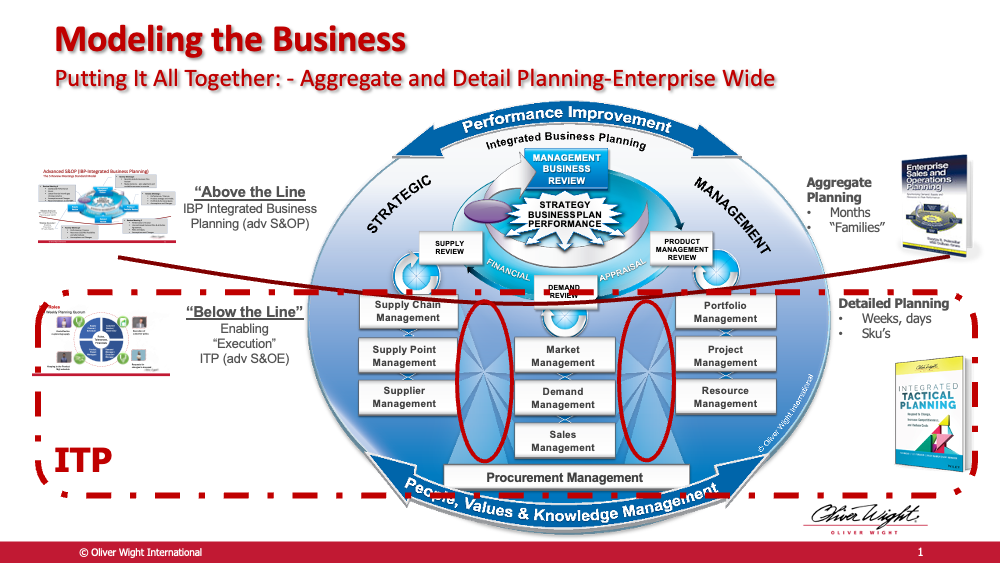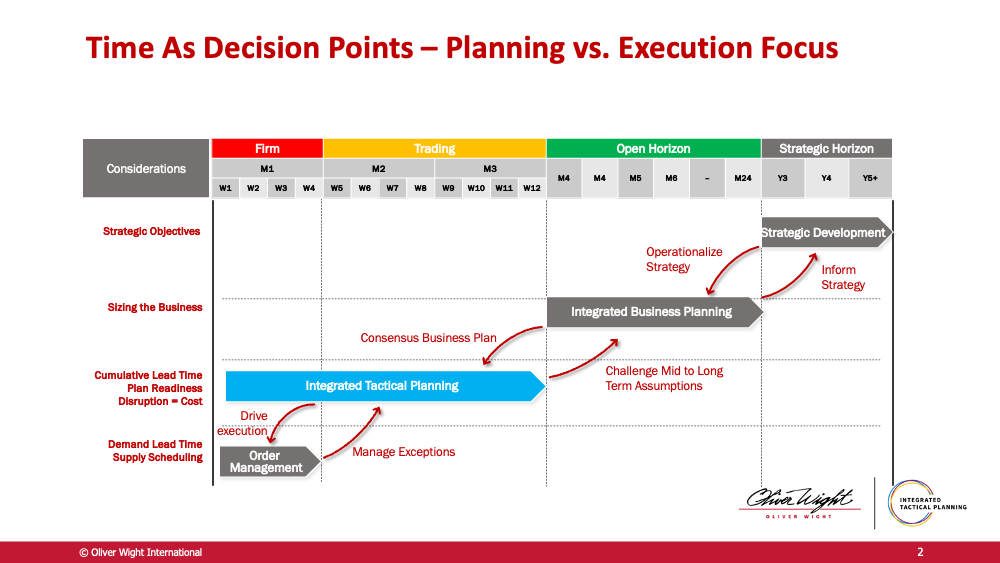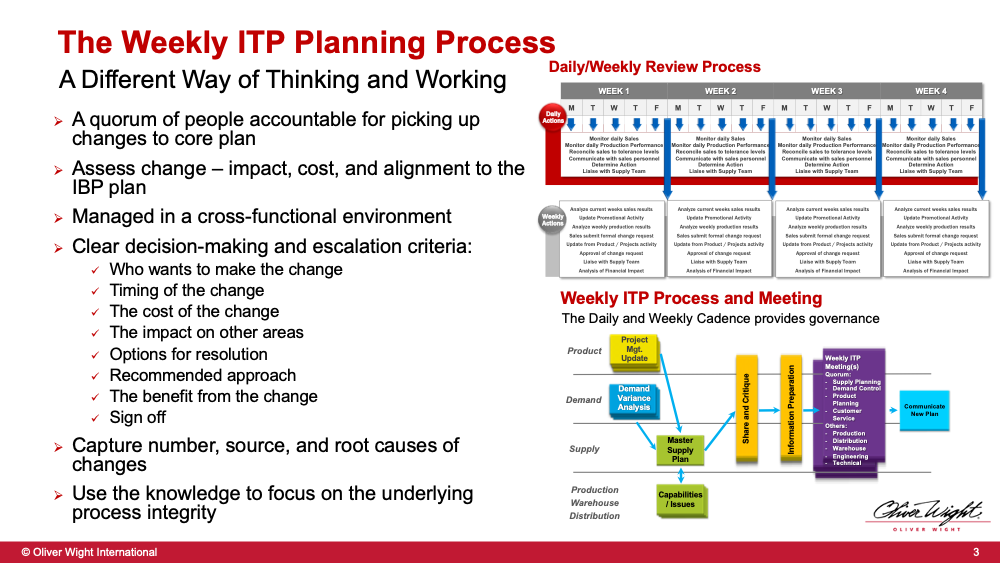by: Todd Ferguson and Wilson Stefano, Jr
In response to changing business conditions that impact near-term execution, many companies run weekly meetings but struggle with an effective process to align changes in product, demand, and supply plans that are instrumental in providing the business with a credible near-term integrated financial outlook. Integrated Tactical Planning (ITP) is the process that will maximizes the financial results or the bottom line dealing with changes in the short-term.
Companies are turning to Integrated Tactical Planning (ITP) to focus on agile and efficient decision-making. ITP is a middle-management process that routinely re-aligns and re-optimizes core process plans. It provides a chaos-free way for cross-functional teams to manage near-term changes to plans. ITP is also intended to make the most efficient use of resources, often real pain points for companies. Sales and Operations Execution (S&OE) and ITP help organizations in different capacities to manage significant changes in the near-term horizon, maximizing the financial result. See Figure 1 and the position of the ITP at the Integrated Business Best Practices Management Processes.
Figure 1

Challenges Organizations Face
To review strategic goals, a routine and regular monthly meeting cycle should be established. During these meetings, the team can make critical decisions using the integrated business model that effectively bridges business objectives 5+ years out to achieve strategic goals. The Integrated Business Planning Process, as it is known, helps effectively operationalize strategy and simultaneously avoid getting buried in unnecessary detail as it focuses on monthly changes covering the horizon 4-24+. However, the Integrated Business Planning Process cannot adequately address a more granular review of required business changes in the next thirteen weeks, for example. See Figure 2 – the bridges business from Strategy to Execution (ITP).
Figure 2

Some of these challenges include changing assumptions around new product introductions, abnormal demand events where customers significantly alter order patterns, and variable manufacturing and supplier capabilities. In our experience, we have found that four key themes cause chaos for organizations when a lack of an Integrated Tactical Planning process exists:
- A tendency to respond to every variation vs. significant abnormalities, believing every change from what was previously agreed to must be solved
- Experiencing urgency to react due to lack of documented time fences that can serve as effective decision points to facilitate discussion and create alignment, while considering financial maximization as well. Remember, changes in the short-term has low flexibility and high costs, so ITP will helps to maximizes it.
- Poorly documented planning assumptions, the existence of which can be helpful to serve as a baseline to understand what really changed when chaos reigns down in the near term
- Lack of clear Roles and responsibilities, resulting in firefighting meetings, and bringing more to the party including executives who in our opinion should be informed but not overwhelmed with details that can be managed by those empowered to make decisions.
Integrated Tactical Planning vs. Sales and Operations Execution
A primary objective of the ITP process is to ensure the execution of previously agreed upon Integrated Business Planning process plans. ITP enables senior management to focus on the four-to-24-month horizon and, in the process, helps liberate the organization. The S&OE process has been defined as a weekly cyclical multistep process that involves at least four subprocesses or steps running in parallel with an underlying financial-alignment process. Others have suggested that the primary goal of an effective S&OE process is to ensure that an accurate and executable plan is generated, beginning with the network level and extending the solution to lower levels of detail, including supply planning, factory planning, and equipment sequencing.
What are the benefits of each plan type?
Both ITP and S&OE can help organizations manage near-term demand and supply changes. However, it is worth pointing out some noticeable differences and corresponding benefits of an Integrated Tactical Planning Process.
Here is a summary of the key differences, between ITP and S&OE::
- Time Fence – intentional definition of using time and associated costs to drive decisions and alignment is a hallmark of an ITP process, not always clear with S&OE.
- Portfolio Execution – several clients have stated that ITP helps them more effectively bring visibility to and manage launches as well as product lifecycles
- Abnormal Demand – not every variation requires technology or human intervention! However, agreeing on these abnormal demands can be challenging – and different depending upon MTS or MTO, for example.
- Improved Financial Integration and decision-making – capturing the cost of changes and highlighting this as an input into more targeted decision-making when changes in plans occur in the near term. S&OE is often seen as a demand/supply balancing exercise.
Figure 3

Where to Start
Implementing an Integrated Tactical Planning process may involve modifying your existing processes or a more intensive design. A practical approach to assess whether Integrated Tactical Planning is right for your organization is to begin by taking our free self-assessment survey. We also have free resources located on our website here, including educational sessions on the ITP process and its benefits.
The feedback and insights will serve you well should you desire to achieve more efficient results across the entire organization.
In most cases, a professional could help evaluate your business needs and advise where there are gaps.
Oliver Wight Business Advisors have the experience it takes to offer a variety of resources and tools to guide your team in the right direction. Identifying gaps in your plan is more manageable with the help of an experienced professional. You save time and money by having this reassurance that you are going in the proper direction.
To learn more about how to get started, contact Oliver Wight today.


